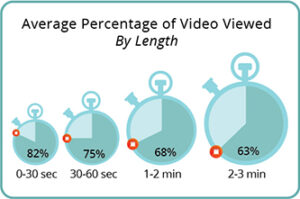I’ve been working with clients to make videos that help their buyers make decisions about enterprise technology solutions for some time. Here’s a summary of the best tips for video content I’ve shared recently.
1. Make several videos from one.
Why? It’s very cost effective and simple to slice and dice even the shortest video into new videos to deploy in new channels. A client of ours recently launched a new product with a lively video about what the product does.
By editing that video, it was a simple task to create a new, less product-centric video, with a modified message emphasizing the company’s unique approach to the problem and their solution.
For the second video we eliminated the voiceover narration, a good practice for noisy environments like trade show exhibits and video walls where there is a lot of competition for viewers’ attention and where adding to the noise level is not a competitive advantage.
2. Embed your videos in other media.
How do you distribute white papers, product sheets, product announcements, news releases, and newsletters? In PDF format, or in email, most likely. And how many of these go out without including any links to videos?
Yet everyone knows that people like videos because videos can make things clear without taking much time or effort. And most people know that videos in email get more opens and more clicks. What’s more, it’s not hard to think of ways to re-use videos in other media. Tip: use a visual video button.
3. Make shorter videos about narrower subjects

Here’s a discussion of the “ideal” video length for different social media platforms.
- Everyone wants your video to come to the point sooner rather than later. Busy people will tune out if your video hasn’t grabbed their interest in the first 30 seconds or so.
- Narrower subjects mean tighter audience focus. You can target the interests of different buying influences better, and you can segment mailing lists better.
- The more concentrated the content, the less people are inclined to add to it or argue with it. In other words, Videos that come to the point faster get produced faster.
4. Reach out more than once along the buyer’s journey.

One of the more startling findings about buying behavior that I’ve run across is this one: the probability of making a purchase drops precipitously as soon as a second person joins the buying team.
So, if your solution has a long sales cycle with many buying influences involved, you need to influence these other influences at different levels of awareness. Like anyone else, they’ll appreciate concise communications that get right to point — so short videos will be useful guideposts for all the buyers on the buyer’s journey.
5. Don’t be too product-centric
Sure, you’re a technology solution vendor, and technology is what your buyers buy. But, because buyers generally don’t contact sales until late in the sales process, it pays to make videos that tell them what they want to know about your technology, as opposed to videos summarizing what you want them to know about your technology.
6. Not everyone needs a demo
The people who are going to be using your solution have different interests from their bosses, from line-of-business executives, and others involved in the buying decision. So, demo videos may be appropriate for users, others may prefer more conceptual approaches. You need more than one kind of video.
7. Be opportunistic
Every video doesn’t have to be awesome. Every video doesn’t need a lot of planning. It just needs to speak to the interest of the intended viewer. A video recorded on a smart phone will serve nicely for a personalized invitation to a conference. A Skype session can serve as the basis of a testimonial or use case. You probably just need to edit a bit, and add narration and graphics for continuity — not a big deal.
You see lots of recorded presentations and webinars on tech company websites, and that’s a good thing. (I’m an advocate of short videos because that’s what my company writes and produces, but, obviously, many buyers will appreciate a deep dive into a subject that interests them deeply.) Look for opportunities to excerpt and repurpose these long videos
8. Think pictures, not messaging
If you want to evaluate the “spend” on an explainer video, try watching it with the audio turned off. If the message is vague or bland, the money was not well spent. Words are cheap. Pictures improve understanding and capture attention, even in noisy environments. Pictures make video video.



